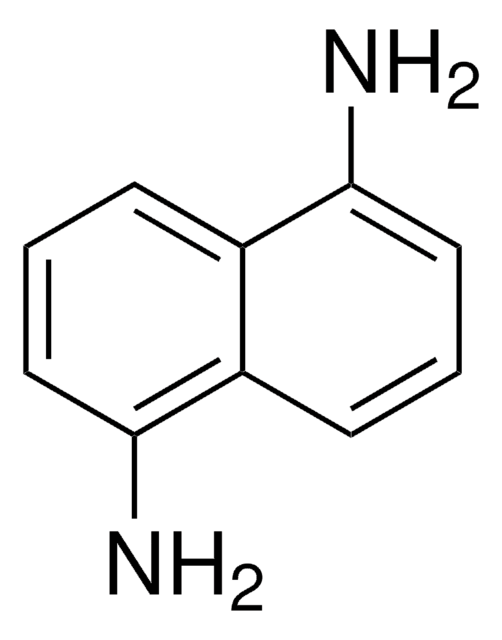49508
Sinapic acid
matrix substance for MALDI-MS, ≥99.5%, Ultra pure
Sinonimo/i:
3,5-Dimethoxy-4-hydroxycinnamic acid, 4-Hydroxy-3,5-dimethoxy-cinnamic acid, Sinapinic acid
About This Item
Grado
matrix substance for MALDI-MS
Livello qualitativo
Saggio
≥99.5% (HPLC)
≥99.5%
Classi chimiche degli analiti
dendrimers, fullerenes, peptides, proteins
tecniche
MALDI-MS: suitable
Punto di fusione
~202 °C
Solubilità
dioxane: 1 g/10 mL at hot, clear, faintly yellow to yellow
Cationi in tracce
Al: ≤1 mg/kg
Ba: ≤1 mg/kg
Ca: ≤2 mg/kg
Cd: ≤1 mg/kg
Co: ≤1 mg/kg
Cr: ≤1 mg/kg
Cu: ≤1 mg/kg
Fe: ≤1 mg/kg
K: ≤2 mg/kg
Li: ≤1 mg/kg
Mg: ≤1 mg/kg
Mn: ≤1 mg/kg
Na: ≤2 mg/kg
Ni: ≤1 mg/kg
Sr: ≤1 mg/kg
Zn: ≤1 mg/kg
Compatibilità
in accordance for UV test
Stringa SMILE
COc1cc(\C=C\C(O)=O)cc(OC)c1O
InChI
1S/C11H12O5/c1-15-8-5-7(3-4-10(12)13)6-9(16-2)11(8)14/h3-6,14H,1-2H3,(H,12,13)/b4-3+
PCMORTLOPMLEFB-ONEGZZNKSA-N
Cerchi prodotti simili? Visita Guida al confronto tra prodotti
Categorie correlate
Descrizione generale
Applicazioni
- Metabolic Fate Characterization: Sinapic acid′s metabolic fate in biological systems is a significant area of research. Recent studies in rats have focused on identifying the metabolic pathways and by-products of sinapic acid, using advanced techniques such as liquid chromatography-mass spectrometry (LC-MS). These studies provide insights into its bioavailability and pharmacokinetics, which are crucial for understanding its therapeutic potential (Analytical and Bioanalytical Chemistry, 2023).
- Efficient Extraction from Plant Materials: Sinapic acid is extracted from various plant sources using molecularly imprinted polymers (MIPs) and deep eutectic solvents. These methods enhance the efficiency and selectivity of sinapic acid extraction, making it a valuable approach for analytical chemists working on natural product isolation and characterization. This application is particularly relevant in the food and pharmaceutical industries for quality control and standardization (Food Chemistry, 2023).
- Selective Sensing Applications: Sinapic acid is used in the development of nanocomposites for selective sensing applications. For instance, Ni-sinapic acid nanocomposites have been developed for the selective detection of permanganate ions. This research showcases the versatility of sinapic acid in creating sensitive and specific sensors for environmental monitoring and analytical applications (Journal of Photochemistry and Photobiology A: Chemistry, 2023).
- Bioactivity Studies: The bioactivity of sinapic acid extends to its anti-inflammatory and anticancer properties. Studies have shown that sinapic acid can modulate various biochemical pathways, providing protective effects against inflammation and cancer. These findings underscore its potential as a bioactive compound in therapeutic formulations and highlight the importance of analytical methods in quantifying its efficacy and safety (Stem Cell Research International, 2022).
Azioni biochim/fisiol
Confezionamento
Avvertenze
Warning
Indicazioni di pericolo
Consigli di prudenza
Classi di pericolo
Eye Irrit. 2 - Skin Irrit. 2 - STOT SE 3
Organi bersaglio
Respiratory system
Codice della classe di stoccaggio
11 - Combustible Solids
Classe di pericolosità dell'acqua (WGK)
WGK 3
Punto d’infiammabilità (°F)
Not applicable
Punto d’infiammabilità (°C)
Not applicable
Dispositivi di protezione individuale
dust mask type N95 (US), Eyeshields, Gloves
Choose from one of the most recent versions:
Certificati d'analisi (COA)
Don't see the Right Version?
If you require a particular version, you can look up a specific certificate by the Lot or Batch number.
Possiedi già questo prodotto?
I documenti relativi ai prodotti acquistati recentemente sono disponibili nell’Archivio dei documenti.
I clienti hanno visto anche
Articoli
Sigma-Aldrich.com presents an article concerning Ultra-pure MALDI Matrices.
Il team dei nostri ricercatori vanta grande esperienza in tutte le aree della ricerca quali Life Science, scienza dei materiali, sintesi chimica, cromatografia, discipline analitiche, ecc..
Contatta l'Assistenza Tecnica.






![trans-2-[3-(4-tert-Butylphenyl)-2-methyl-2-propenylidene]malononitrile matrix substance for MALDI-MS, ≥99.0% (HPLC)](/deepweb/assets/sigmaaldrich/product/structures/249/587/f8021369-f65a-413d-887d-3c8a4d2a248f/640/f8021369-f65a-413d-887d-3c8a4d2a248f.png)